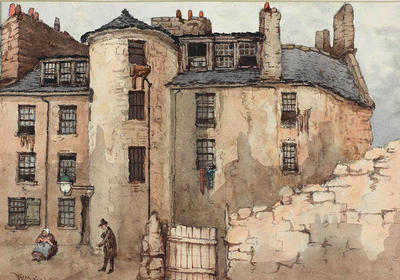
[The following is general information about Kharschum that your characters would be able to glean from casual conversations with NPCs during your first few days in the city.]
Kharschum is, in many ways, two distinct cities, each of which has its own identity and power structure. The Western City, with its tidy shops and elegant villas, is where most of the wealth and power in Kharschum resides. The Eastern City, with its narrow, filthy streets and sprawling shantytowns, is where most of the humanity of Kharschum resides. Though the residents of the Western City sometimes pretend that the Eastern City does not exist, they are nonetheless willing to take advantage of whatever opportunities it might offer. Likewise, though few denizens of the Eastern City can ever hope to afford even the most modest home on the western side of the river, many scheme endlessly to accomplish just that.
Kharschum is ruled by an administrative body known as the Council of Three, which exercises tight control over the Western City and occasionally projects its power into the Eastern City, though for the most part, the Council seems content to leave the Eastern City to its own devices. The Council's three members are known and feared throughout Kharschum: Chiledu, Khan of the fearsome Khatagin Clan, who enriched himself through hundreds of military victories across the war-ravaged countryside; Irina, governess of the Slavers' Guild and scion of one of Kharschum's most prominent families; and Bataar, an elegant, middle-aged man about whom little is known. Chiledu commands the City Guard, many of whom are his clansmen, and most of whom are said to be less concerned with maintaining order than with fattening their purses. The Slavers' Guild maintains its own guard, easily distinguished by its scarlet tunic, which Irina exercises control over. Bataar's power base is unknown, though there is much speculation.
Though the Council of Three holds much of the city's political power, the various guilds enjoy a great deal of economic power, with which they subtly influence the city's affairs. Not surprisingly, the Slavers' Guild is most prominent, though the Merchants' Guild, the Sailors' Guild, and the Mercenaries' Guild have considerable influence, as they play pivotal roles in the city's commerce and defense. The remaining guilds, of which there are dozens, have little political or economic influence, and mainly serve to advance the interests of their members.
The Eastern City is controlled by three gangs which impose a crude, exploitative order on their territories, whenever they are not warring openly with each other. The Severed Hand, named for its favorite method of persuasion, is led by a notorious thug named Bathcat, and controls the shantytowns and dockyard slum on the city's southern fringe. The Red Nails, led by the reclusive Ophidia, controls most of the old city south of the Coliseum District, while Roknar's Fist maintains a precarious balance of power with the Mercenaries' Guild in the Coliseum and Theatre Districts.
Religion plays an important, if secondary, role in the city's affairs. The Church of Wee Jas is ascendant, though recently a rift has opened among the goddess' worshippers. The dominant sect, the Church of the Ruby Goddess, emphasizes law and domination, and claims most of Kharschum's influential citizens as its members. However, a new sect, the Disciples of the Quietus, which emphasizes magic and death, has recently begun to gain influence. Its clerics rail against the politically entrenched Church of the Ruby Goddess, and claim to follow the pure aspect Wee Jas. The Church of the Ruby Goddess ruthlessly suppresses the Disciples of the Quietus, but the new movement has gained so many followers that it threatens to gain dominance and upset the precarious power structure of the city.
Temples to other deities are scattered throughout the city, though none are nearly as influential as the Church of the Ruby Goddess or the Disciples of the Quietus. Of these, the Temple of Olidamarra is famous for its bacchanalian revels, while the Iron Tower of Vecna is infamous for what is rumored to happen within its rusted, monolithic walls. Many of the fighters and mercenaries who frequent the Coliseum District worship at the Temple of Kord, located near the Coliseum Market, while the city's goblinoid residents worship at the Temple of Maglubiyet in the Hobgoblin Ghetto.
There are other organizations in Kharschum which people seem to know little about, or fear to speak of openly. An organization known only as the Unseen Eye operates in the Western City, though few people seem to know whether it is an individual, a criminal organization of some sort, or something far more sinister. There is an Assassins' Guild somewhere in the city, but only those with both money and an unspeakable need ever seek it out. An underground organization called the Shadow of Pelor operates throughout the city, spiriting slaves to freedom.
You will certainly come into contact with some of these figures and organizations as you seek your fortunes in Kharschum. Know these things well, and tread carefully.
4 comments:
Wow. I guess a round of a hundred or so drinks at the Sailor's Guild buys an awful lot of info.
Seriously though, thanks for the post. The city is fascinating and I cannot wait to delve deeper into the intricacies of Kharschum's political scene. Great stuff.
This is just great, dm. Lots of potential hooks and lots and lots of new places to visit.
Thanks for helping to bring Kharshum to life for us.
I piggy-back on the above comments.I know how hard you've been working on Kharshum, and am excited to explore, and conquer.
Looking forward to Friday....
Thanks everyone. I've had a really good time developing Kharschum, so much that it's been difficult to force myself to do other, "important" work.
Indeed, Ironbeard, those sailors are a gregarious lot with an uncanny knowledge of city politics. :)
Post a Comment